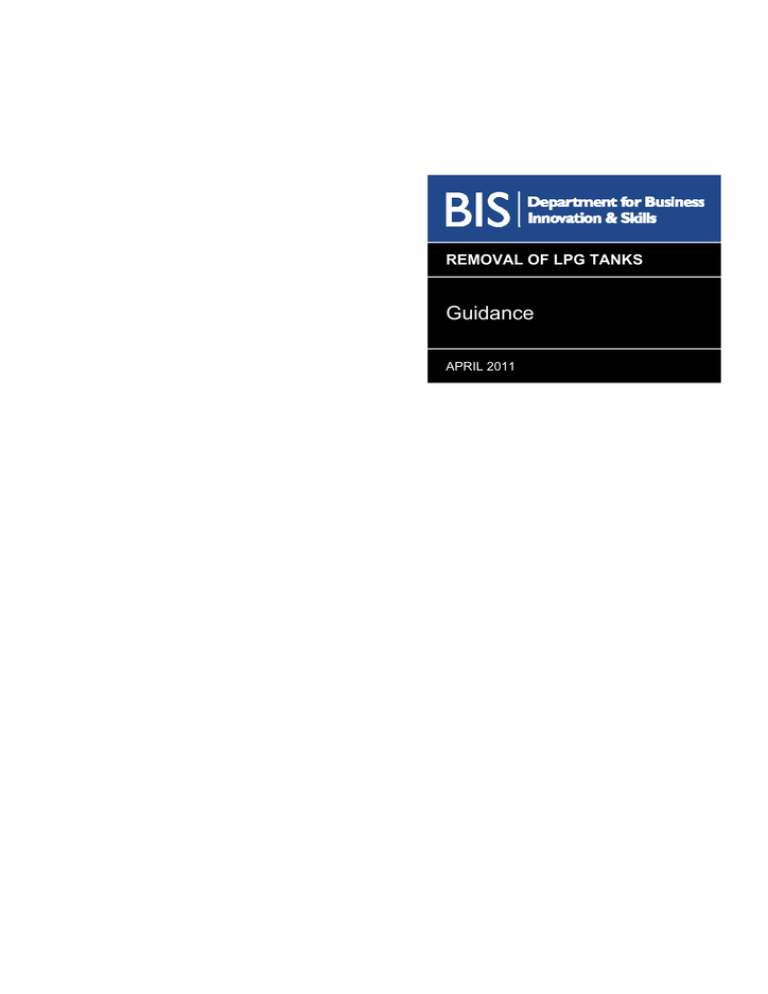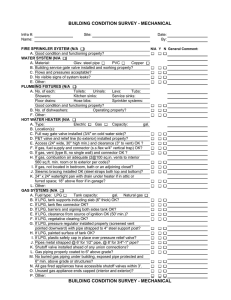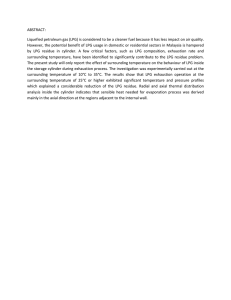Removal of LPG Tanks Guidance
advertisement

REMOVAL OF LPG TANKS Guidance APRIL 2011 GUIDANCE ON REMOVAL OF LPG TANKS These notes should be read in conjunction with the DEFRA/BIS guidance, “Depolluting End-of-Life-Vehicles, Guidance for Authorised Treatment Facilities”. They are not an authoritative set of instructions, as individual vehicles may vary considerably. They are merely guidance to inform operators of the main issues to help them develop their own risk assessment prior to embarking on this task. There will be safety issues surrounding the carrying out of any vehicle depollution activity; neither Defra nor BIS will accept any liability for death, personal injury or any other damage howsoever arising as a result of undertaking any of the activity covered by this guidance. Currently, relatively few ELVs in the UK have LPG tanks, but the number is likely to increase in the future. The usual procedure for removing these is to: 1. 2. 3. 4. Ensure an isolating valve is in place/activated Cut through or disconnect the connecting pipes Cut through or remove the retaining clamps or straps Remove the tank to safe storage Properties of LPG: LPG vapour is readily flammable when mixed with air in the right proportions; it is this property which makes it suitable as a fuel. A cloud of LPG vapour is always flammable at its interface with air. It is its flammability that makes LPG potentially dangerous if improperly handled. • It is stored as a liquid under pressure (6.9 bar/100psi). Leakage of liquid will result in the generation of significantly larger volumes of flammable gas. • LPG vapour is heavier than air and may therefore flow along the ground or through drains and will sink to the lowest level of the surroundings. If efforts are not made to disperse any accumulation, it may remain there for a long time, with the potential for ignition at a considerable distance from the source of leakage. • A tank which has held LPG and is ‘empty’ will still contain LPG in vapour form and is thus potentially dangerous. In this state the internal pressure is approximately atmospheric and if a valve is leaking or is left open, air can diffuse into the container forming a flammable mixture and creating a risk of explosion. Alternatively, LPG can diffuse to the atmosphere. • Rapid vaporisation of released LPG liquid results in lowering of the temperature and can cause severe frost burns if in contact with the skin. LPG is naturally odourless and non-toxic. For safety reasons, a sulphur odorant is added before distribution. It is an anaesthetic when inhaled in significant quantities over a prolonged period. If inhaled at higher concentrations, the vapours produce 2 nausea and headache. Inhaled in extremely high concentrations, asphyxiation and blood saturation can result. Health and Safety Considerations: There are health & safety issues involved with removal, handling and storage of LPG tanks. Consideration must be given to the hazard of working in an explosive atmoshere and only ATEX-approved equipment should be used. ATFs are recommended to check with the Health & Safety Executive (HSE) on current guidance. Only suitably trained personnel should be allowed to work on LPG vehicles before the LPG tank is removed. Under no circumstances should an LPG equipped vehicle be baled and/or sent to the shredder with the LPG tank still installed or intact, even if thought to be empty, as any residual vapour in it would still be explosive. LPG tanks should never be drilled or pierced to remove the LPG. 3 Whenever an LPG equipped vehicle is identified, it should be quarantined in an open area, so that the tank can be isolated and removed for emptying, purging and separate disposal by suitably qualified personnel. The LPG equipment and pipes should be checked for gas leaks using proprietary, ATEX-approved detection equipment, especially in the vicinity of the tank connections. If the battery is situated close to the LPG tank, for example in the boot, it should not be disconnected until it is certain there are no gas leaks (see below) to eliminate the risk of an electrical spark igniting the gas. If there is a gas leak, this must be dealt with as a priority. If there are no qualified personnel on site, the urgent assistance of a local LPG installation company should be sought – for details of companies, see http://www.uklpg.org/lpg_property/UIS019.pdf. LPG liquid is a gas under pressure, which expands rapidly as it emerges causing a severe temperature drop in the vicinity of its release. Anyone attempting to disconnect the tank connections should therefore be equipped with hand and eye protection to avoid freeze burns. The tanks themselves are heavy and should be handled using appropriate lifting tools or supporting frames to avoid injury to personnel. After the tank has been removed, the remainder of the vehicle can be processed as a normal ELV. The LPG injection equipment in the engine compartment and the pipes leading to it do not have to be removed. Information on treatment of removed LPG tanks should be sought from authoritative sources (e.g. the LPG tank supplier or conversion company, LP Gas Association, CARE Group etc.). ATFs may decide that subsequent LPG tank emptying, purging and destruction should be carried out by specialist third party decommissioners. Removed tanks should be stored in the open air in appropriate racks/cages until they can be collected or treated by the qualified disposal agents. LPG, which is mainly used in some cars and light vans, should not be confused with Compressed Natural Gas (CNG), which has been used in some commercial vehicle and PSV applications. CNG is equally hazardous, but is stored at a much higher pressure. Only fully qualified technicians should deal with CNG vehicles in accordance with the vehicle manufacturer’s instructions. Operating Procedure: Identify LPG Vehicle. An LPG vehicle may or may not have identification badges, but can often be recognised by the presence of an additional filler connection valve adjacent to the normal petrol filler or at an alternative location, usually at the rear of the vehicle. The absence of a spare wheel, or anywhere to put one, is another clue. In the engine compartment, there will normally be additional pipework and wiring from the control modules that handle the switching between petrol and LPG. If it is feasible, it is best to run the engine to empty as much fuel as possible from the tank before commencing removal, as this will reduce the weight of the tank and the risk of vapour loss. NOTE: Even after running to empty, the tank will still contain some residual gas vapour, and the full removal procedure must still be followed. Locate and Identify LPG Tank. There are three main types of LPG tank in use in the UK, although others may be found in privately imported vehicles. The two most common ones are cylindrical, often used on light commercial vehicles, and toroidal (doughnut shaped), which fit either in the spare wheel well or underneath the floor where the spare wheel might be hung. Either of these shapes could also be installed in larger vehicles such as 4x4s. These vehicles may, instead, have the third type of tank, sill tanks, which are narrower cylindrical tanks mounted below the door sills. 4 Some Typical LPG Tanks: Cylindrical Tank: Toroidal Tank in Spare Wheel Well: (Note close proximity of battery.) Sill Tank: Under-slung Toroidal Tank: 5 Check For Gas Leaks. Although LPG tanks are quite robust, it is possible that the connections to the tank or pipes in an old, or accident-damaged vehicle could have been fractured, allowing gas to leak into any adjacent low points. Inexpensive proprietary, ATEXapproved equipment is available that can identify the presence of a leak so that it can be dealt with as a priority before proceeding with further dismantling. This is particularly important if the battery is located near the LPG tank in the boot (see picture above), as the battery would normally be removed as the first depollution operation and any sparks could ignite the gas. A vehicle with a persistent or significant leak should be quarantined in the open air, in an area from which smoking and naked flames are prohibited, and professional assistance from an LPG specialist should be sought to deal with it - for details of companies see http://www.uklpg.org/lpg_property/UIS019.pdf. Hand-held Gas Detector: Gas Detector in Use: Turn off or Activate the Isolating Valve(s): All LPG tanks have two isolating valves, one on the inlet and one on the outlet connection. The inlet valve, on the pipe from the filler connection, is a one way valve that needs no special attention (provided it is not leaking). When the pipe is eventually disconnected or cut, the only loss of gas will be the small amount remaining in the filler tube. The outlet valve, which is connected to the pipe leading to the engine, must be closed before the pipe is cut or disconnected. There are two types of outlet valve, mechanical and electrical. Electrical valves have been mandatory on new installations in UK since 2001, although they may be found in some earlier models. But they could be absent altogether from earlier installations or privately imported (usually east European) vehicles, relying only on a manual valve. Electrical valves can usually be identified by the presence of electrical cables leading to the unit, though care must be taken to distinguish between these and similar wires used for the fuel level sensor. Electrical valves operate in a “fail-safe” manner; i.e. they are closed when there is no electrical supply. Therefore, it is safe to assume that if there is no battery or the connecting wires are cut, the valve will be closed. Some electrical valves also have mechanical activation (identified by a knurled screw) and if fitted then this should be screwed in as an additional precaution. Where there is only a mechanical valve, this must be closed manually. It is usually a knurled screw, which must be screwed inwards until it reaches a firm stop. In most installations, this should be in a protected location, either in the boot or, if the tank is under-slung, concealed by a cover, which would need to be removed to provide access. Occasionally, however, the protection may be missing from an under-slung installation, with the possible result that the 6 valve could be corroded or covered with mud. In this event, care should be taken to clean and lubricate the valve before attempting to close it. If there is no such valve on the tank, then professional assistance from an LPG specialist should be sought to deal with it - see http://www.uklpg.org/lpg_property/UIS019.pdf. Some Typical Isolating Valves: Electric Valve with Supplementary Manual Screw: Electric Valve on Cylindrical Tank: Electric Valve in Under-slung Tank (with cover removed): 7 Disconnect the Pipes: This operation should never be carried out over a pit because of the risk of accumulation of heavier than air gas within the pit. Only after the isolating valves have been closed should the connecting pipes be disconnected. IMPORTANT NOTE: A small amount of gas under pressure will escape from the connections when this is done. As a result, it will become extremely cold; and hand and eye protection should be worn. It is probably best if the operator temporarily leaves the vicinity for a few minutes to allow the gas to dissipate before resuming dismantling. At first, a single pipe connection should be slackened so that any liquid LPG in the pipe can disperse in a controlled manner. Once the liquid LPG has all dispersed, the pipes can be fully disconnected, preferably using spanners or mechanical cutters. Once the pipe has been disconnected, the valve should be checked to ensure that it has a tight shut off by the use of an ATEX-approved gas detector or soap solution. IMPORTANT NOTE: If, after turning off the isolation valves, gas or liquid, other than a small spurt, continues to escape when the pipe unions are undone, these should be retightened and assistance sought from the nearest professional LPG installer, whose details can be found at: http://www.uklpg.org/lpg_property/UIS019.pdf. Meanwhile, the vehicle should quarantined in an open area and should not be worked on until the LPG tank has been properly isolated and removed. Unbolt fixings or cut mounting straps: Tanks which are located inside the vehicle are usually bolted into the spare wheel well or firmly mounted to suitable pads to prevent movement. Care should be taken as the bolts are undone, in case the tank could shift and trap the operator’s fingers. Tanks that are slung under the vehicle should be supported on a suitable rig to take the weight as the fixing bolts are undone. If fixings or mounting straps have to be cut, only cold cutting methods (e.g. bolt cutters) should be used. Never use a cutting disk or oxy-acetylene. Remove the Tank from the Vehicle: Once the fixing bolts have been removed, the tank may be removed from the vehicle. IMPORTANT NOTE: The tanks are heavy, even when empty, but especially if they still contain some liquid LPG fuel, and care should be taken when lifting them. For tanks located in the spare wheel well, a pair of (or preferably four) lifting handles (see picture) may be inserted into the threaded holes after removing the retaining bolts, so that an operator (or preferably two) can get hold of it to lift it out. There are two thread sizes in common use (M10 x 1.25 and M10 x 1.5), and lifting handles of both sizes should be made available. After removing the tank, the vehicle from which it has been removed can be processed as any other ELV, and the LPG injection equipment around the engine may be ignored. 8 Place the Tank in Safe Storage: After the tank has been removed from the vehicle, it should be placed on a suitable rack in a lockable wire cage in the open air for storage until a professional LPG operator can come in to empty and purge it ready for final disposal. Operators may choose to wait until they have several tanks for disposal before calling in a specialist, in order to minimise the unit cost. A list of qualified LPG specialists with the necessary tank emptying or purging equipment can be found at http://www.uklpg.org/lpg_property/UIS019.pdf. March 2011 URN 11/849 9



